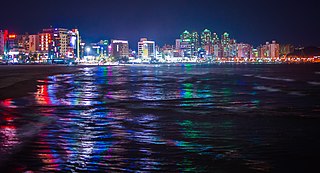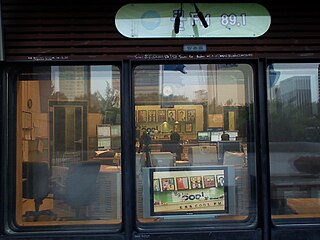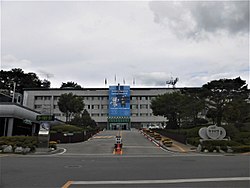
Daejeon is South Korea's fifth-largest metropolis, with a population of 1.5 million as of 2019. Located in a central lowland valley between the Sobaek Mountains and the Geum River, the city is known both as a technology and research center, and for its close relationship with the natural environment. Daejeon serves as a hub of transportation for major rail and road routes, and is approximately 50 minutes from the capital, Seoul, by KTX or SRT high speed rail.

Pohang, formerly spelled Po-Hang, is the largest city in North Gyeongsang Province, South Korea, with a population of 499,363 as of 2022, bordering the East Sea to the east, Yeongcheon to the west, Gyeongju to the south, and Cheongsong and Yeongdeok to the north.

Yeosu, formerly romanized as Yosu, is the second largest city in South Jeolla Province, South Korea. In 1998, the Old Yeosu City, Yeocheon City and Yeocheon County were merged and the current city, Yeosu, was formed.

Kangwon Province is a province of North Korea, with its capital at Wŏnsan. Before the division of Korea in 1945, Kangwŏn Province and its South Korean neighbour Gangwon Province formed a single province that excluded Wŏnsan.

Wonju is the most populous city in Gangwon Province, South Korea, with a population of 364,860 as of 2023. The city is located approximately 140 kilometres (87 mi) east of Seoul.

Hongcheon (Hongcheon-gun) is a county and city in Gangwon Province, South Korea. The city lies on the northern bank of the Hongcheon River, southeast of Chuncheon. The terrain of the county is mainly mountainous and contains hot springs in the Hongcheong River valley. The county produces ginseng, maize, and vegetables. As of 2012 the county had a population of 70,401 people in 29,894 households.

Inje County is a county in Gangwon Province, South Korea. It has the lowest population density of any South Korean county. The county seat is Inje-eup, which located near the center of the county.

Pyeongchang is a county in the province of Gangwon-do, South Korea, located in the Taebaek Mountains region. It is home to several Buddhist temples, including Woljeongsa. It is about 180 km (110 mi) east southeast of Seoul, the capital of South Korea, and connected by expressways and high-speed passenger railways. Pyeongchang's slogan, "Happy 700 Pyeongchang", is taken from its average elevation of approximately 700 metres (2,300 ft).

Pocheon (Korean: 포천; Korean pronunciation:[pʰo.tɕʰʌn]) is an inland city in northeast Gyeonggi Province, South Korea. It covers 826.48 km (513.55 mi)2 with a population of 160,176 people, according to the 2008 census. Pocheon lies between Seoul and the mountainous northwestern areas of Gangwon Province. The city borders Yeoncheon county, with the cities of Dongducheon and Yangju to the west, along with Uijeongbu, and Namyangju of Gyeonggi province to the south. It also borders Hwacheon county of Gangwon province on its eastern border and Cheorwon is to the north. Alongside the adjoining Gapyeong, Pocheon consists of the highest mountainous areas in Gyeonggi province. The current city of Pocheon was created after Pocheon-hyeon and Yeongpyeong counties were merged. The north part of the city used to be part of Yeongpyeong county while the south used to be part of Pocheon-hyeon.

Geumsan County is a county in South Chungcheong Province, South Korea. It borders Muju County, North Jeolla Province (Jeollabuk-do), which is famous for its ski resort nearby.

The Catholic Diocese of Wonju is a diocese of the Latin Church of the Catholic Church in located in Wonju, South Korea. It is a suffragan to the Archdiocese of Seoul.

Odaesan, also known as Mount Odae-san or Mount Odae, is a major cluster of mountains and national park in eastern Gangwon Province, South Korea, standing at the junction of Gangneung City, Pyeongchang County and Hongcheon County. It stands at the junction of the Taebaek Mountains and the Charyeong Mountains, a spur range stretching to the west and serving to divide the South Han River / Namhan River from the North Han River / Bukhan River. It stands just to the south of Seoraksan and north of Dutasan along the Baekdu-daegan Mountain-system mainline, the range of granite peaks that make up the symbolic spine of the Korean Peninsula, but its peaks are more rounded and forested than most. National Highway 6 runs through the park, between the south main-entrance and the northeast corner descending to the east coast. It contain five main peaks surrounding a deep main valley running north to south, and several other subsidiary peaks, such as Noin-bong, with gorges between, a watershed forming a river leaving this area to the south. Just outside the western boundary of the national park area, another mountain Gyebangsan rises to 1,577 m (5,174 ft), higher than conventional Odae-san's summit, and they are connected by a 10 km long ridge; it is controversial whether or not to include this within the cluster or consider it as separate.
Gyebangsan (Korean: 계방산) is a mountain between the counties of Hongcheon and Pyeongchang, Gangwon-do in South Korea. It has an elevation of 1,577 m (5,174 ft).
Maehwasan is a South Korean mountain between Hoengseong County and Wonju, Gangwon-do. It has an elevation of 1,085 m (3,560 ft).

National Route 42 is a major highway in South Korea, connecting Incheon with the city of Donghae, Gangwon Province.

KBS Cool FM, also known as KBS 2FM KBS 제2FM방송) is a 24-hour Hot AC music and entertainment radio station of the Korean Broadcasting System. It plays mostly older K-pop Music from the 90s compared to KBS Happy FM which plays the latest K-pop tracks. Notable shows include Gayo Plaza, Volume Up and Kiss the Radio.
National Route 19 is a national highway in South Korea connects Namhae County to Hongcheon County. It established on 31 August 1971.

Kōgen-dō, alternatively Kōgen Province, was a province of Korea under Japanese rule. Its capital was Shunsen (Chuncheon). The province corresponds to the combination of the modern Kangwon Province, North Korea and Gangwon Province, South Korea.



















